Integrated Pest Control – IPM
If managing litter, manure, or compost, farmers need to pay close attention to pests that may be attracted to these materials. Diseases have been known to spread by pests to farms simply because there were piles that attracted them to the farm. Integrated pest management (IPM) is a methodology that involves four major phases.
- A farm will set an IPM into place. Including action points for increased suppression of pests
- The farm will monitor, and measure levels of pests being controlled.
- The program will be reviewed, and practices evaluated for effectiveness.
- Adjustments are made to the program and then the program runs for another cycle.
By going through the cycle over time you produce a continuous improvement program to increase the chances of success. Documentation is an important part of this simply so you “know where you are” as it relates to pest control.
Environments
Pest management needs to be adaptive to the environments where pests can accumulate. Special scouting needs to be employed in differing environments where materials are held. Some environmental conditions to concentrate on if present:
Bins
Structures for holding manure and mortality compost in a dense area. Pests can use this as harborage or feeding if left unattended for a period or poorly built in the case of mortality composting.
Windrows
Stacks of materials such as litter, or mortality compost, that at times can draw pests in looking to scavenge for food or shelter. Biosecurity can be compromised if composting windrows fail to reach critical temperature (131oF for 3 consecutive days) and Birds and other vertebrates dig into the windrows. Windrows need to be constructed so that water entrapment will not occur between windrows, nor allow runoff to impact any waterways.
Stacked piles
These are staged piles in fields awaiting spreading after crop removal or prior to planting. If carried directly from poultry housing, flies, beetles, and other pests could be carried to the field and closer to neighbors. Proper handling, storage and curing of manure and litter is necessary to prevent pest spreading.
Manure Storage Structures
Formal storage of manure and litter inside poultry housing or in specifically built storage buildings. These pose harborage sites for many pests that could lead to an increase in pest populations on the farm. Proper ventilation is needed to help keep materials dry. Adequate monitoring is needed to help control pests in these areas, and to prevent their spread.
Rodents
Impacts by damage from rodents (rats & mice) can be catastrophic when you consider fire caused by rodents chewing on wires in poultry housing. In some cases, a complete loss of animal life and building. Rodents can play a significant role in spreading poultry diseases and bacteria such as Salmonella Enteritidis (SE) as they scurry from manure to feed trough leaving droppings (mouse rice) that is easily seen by chickens and turkeys. With a short life cycle and large litter size, a mouse or rat infestation could grow to a larger problem quickly. Nesting holes in stacked materials that have been sitting outside are tell tell-tale signs that attention is needed.
Identification of these rodents is mostly by size, however young rats and mice can be confusing. Knowing what species of rodent will determine methods of control.
Mice are petite in conformation and have tails that are almost as long as their bodies. Mice have small feet and heads when compared to young rats. Mice sometimes will have white belly fur such as with the deer mouse. Rats are extremely muscular and will venture further from their home base than will a mouse. Roof rats are noted for climbing and nesting in attics and walls of poultry housing. These rodents are known for riding in trucks with materials and form new colonies where they land.
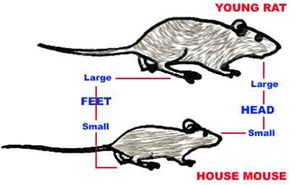
Mice are frequent feeders that will only venture a short distance from their home base. Normally you will see them running along structures. Harborage near food sources are common collecting points for these rodents. Rats on the other hand will venture further out from home to forage and eat larger, less frequent meals. Rats will look for open water sources as well and congregate near water. Litter size and frequency make the multiplicative effect of rodent populations a concern for any farm. Since there is feed found in manure and litter this could potentially pull rodents into a farm, shed or field.
INSERT TABLE HERE
| Characteristics | House Mouse | Norway Rat |
|---|---|---|
| Home range | 9-30 ft | 20-300 ft |
| Longevity | 12-15 months | 12-15 months |
| Sex maturity | 45 days | 90 days |
| Litters per year | 5-11 | 4-12 |
| Young/litter | 3-11 | 8-10 |
| Daily feeding | Many | Usually 2 |
Monitoring & indexing of rodents is the core part of an IPM program. For most applications trapping rodents is the most common method of counting rodent numbers. Repeating bucket and box traps work best but snap traps for rats and mice that are “pinned” to keep from being dragged away can be deployed for counting.
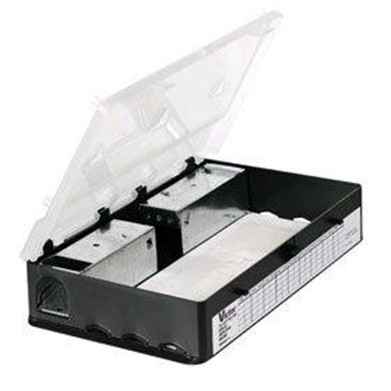
Inside average poultry buildings a normal deployment for counting is 12 traps for one week in time. For exterior locations repeating traps could be set every 30 around the perimeter of the material you wish to control. When using more traps or using more than 7 days of monitoring, then an adjusted mouse number can be calculated:
Adjusted Mouse Count =
(# mice caught) x (12/# traps deployed) x (7/# days deployed)
Using either the direct method or adjusted rodent count, the rodent index (RI) can be assigned for that time period based on rodent counts:
| Mouse Count | Mouse Density Level | RI |
|---|---|---|
| 0-10 | Low | 1 |
| 11-25 | Medium | 2 |
| 26 + | High | 3 |
Table source PEQAP
If no rodents are being caught, then a RI of zero could be recorded. RI numbers above a one would constitute an action point and some form of rodent control (correction) would need to be deployed. A log of rodent counts and corrective actions taken should be kept for 3 years.
Controlling rodents can be on a graded effort with increasing lethality and higher expense. The IPM program always looks towards cultural methods as the primary method of controlling rodents. As we increase the level of intervention the lethality to others also increases. This is why at the apex of control, chemical that the upmost caution needs to be employed to not harm non-targeted animals. IPM Control examples include:
Cultural
Picking up litter and manure from around poultry housing. Cutting vegetation down to less than 6 inches in height. Stirring static piles and compost piles to eliminate harborage and increase composting pile temps. Adding more capping material to windrows near rodent activity spots. Eliminating debris from near material piles to keep harborage spots down. Use of crushed stone as a 3-foot barrier around composting and manure storage sheds to keep ingress from rodents down. All entrances to
spots down. Use of crushed stone as a 3-foot barrier around composting and manure storage sheds to keep ingress from rodents down. All entrances to manure storage should be blocked to rodents. This includes fan shrouds, and manure belt outlets to buildings.
Physical
Using traps (box or bucket) that would be distributed around the perimeter of the material you are trying to control. Snap traps can also be deployed but have to be connected to a stake (pinned) to prevent run-away events of trapping.
Biological
If material is open to the environment, then natural predation is in play. Some farms will place hawk and owl boxes to encourage nesting near the farm. This will not work well with organic farms and other programs that require outside access.
Chemical
Single feed rodenticides can be placed in feeding stations then distributed around the materials you are trying to protect. Bait boxes with pins to keep bait within the box is favored. Home made bait tubes can be made so long as bait can be pinned within the tube. Log all bait deployed and check stations to monitor feeding of the bait. Pick up any dead rodents discovered & dispose properly to help prevent poisoning of non-target animals and wildlife. The use of a small scale to weight bait supply buckets helps speed monitoring of baiting activities.
Classes of Rodenticides
| Botanicals | Indandione | Organophosphorus |
|---|---|---|
| Scilliroside | chlorophacinone | phosacetim |
| strychnine | diphacinone | |
| pindone | Urea | |
| Coumarin | pyrinuron | |
| Brodifacoum | Inorganic | |
| Bromadiolone | arsenous oxide | Unclassified |
| Coumachlor | phosphorus | bromethalin |
| Coumafuryl | potassium arsenate | α -chlorohydrin |
| Coumatetralyl | sodium arsenate | ergocalciferol |
| Difenacoum | thallium sulfate | fluroacetamid |
| flocoumafen | zinc phosphide | flupropandine |
| warfarin | hydrogen cyanide | |
| Pyrimidinamine | norbormide | |
| Organochlorine | crimidine | sodium fluoroacetate |
Rodenticides are classified by their active ingredients. It is important to rotate between active ingredients in order not to develop resistance by rodents to the bait. Consult your supplier for a suggested bait rotation program to optimize control. All baits should be stored in their original containers in locked storage, and only used by adults on the farm.
Flies
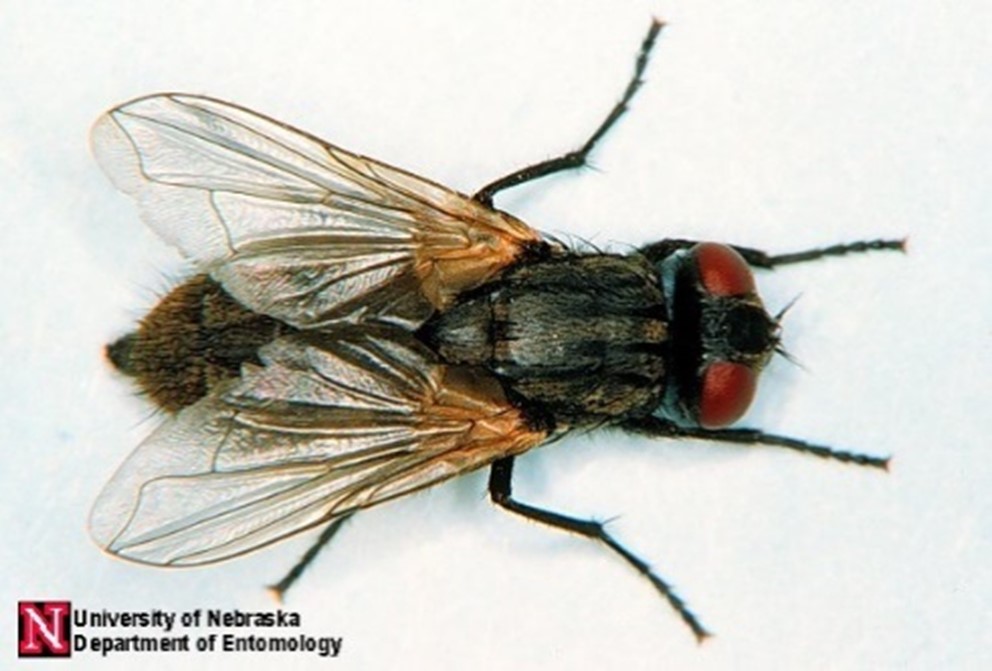
Credit: University of Nebraska Entomology
Flies of differing species can impact poultry farms and surrounding areas. Flies commonly can breed and feed in manure and composting storage causing a dramatic uptick in activity in a very short time span. Because flies are in direct contact with manure they can serve as a fomite and transfer disease to poultry. It is not uncommon for birds to eat flies thus ingesting whatever was covering them.
Identification
Flies can be identified by their shape, size, flight/behavior and what they are feeding on. House flies are the most common fly on a poultry farm. These non-biting flies are fast flying and have a striped thorax. Their wings fold to a triangle shape and their abdomen extends beyond the wings. This fly has a four stage life cycle and can go from egg to adult in less than 10 days in 80oF weather. Manure and other media around 60% moisture will attract fly breeding. It is common for these flies to cluster on walls and posts near hatching sites to dry their wings.
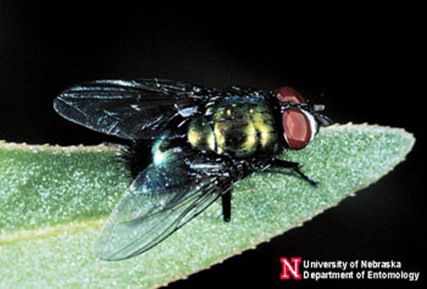
Credit: University of Nebraska Entomology
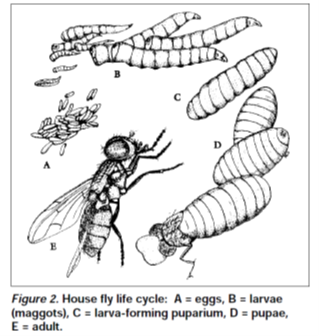
Credit: University of Nebraska Entomology
Blow Flies by contrast feed on dead and decaying organisms. These flies are common around dead birds that are exposed. Their thoraxes and abdomen are shiny metallic in color and can take a black, green or blue hue. These are true scavengers, so if found surrounding composting mortality, added carbon to the compost mix is indicated.
Filth flies have a four stage life cycle. For house fly it takes only 10 days to go from egg to adult at 80oF environment. This life cycle knowledge is key to control simply fi you can control two of the four stages of the life cycle, control should be attainable.
Monitoring & Indexing flies can be completed with simple monitoring stations. House flies can be counted with 3×5 inch white index cards that are posted around the area you wish to monitor. If you are over 100 specks per card on average, then you have reached a control point. Graphing fly counts over time can aid in monitoring fly activity and control. Blow flies and other types of filth flies can be counted using fly ribbon deployed over a week. Fly counts over 100 on average would constitute an action point in fly IPM programs.
A fly index (FI) can be used to rank severity of fly populations.
Fly Index Levels:
- Establish threshold for action point.
- FI = 1, Low: 0 – 50
- FI = 2, Moderate: 51-100
- FI = 3, High: > 100
IPM Controls for filth flies. Using the pyramid of increasing intervention there are several steps that can be taken to control flies
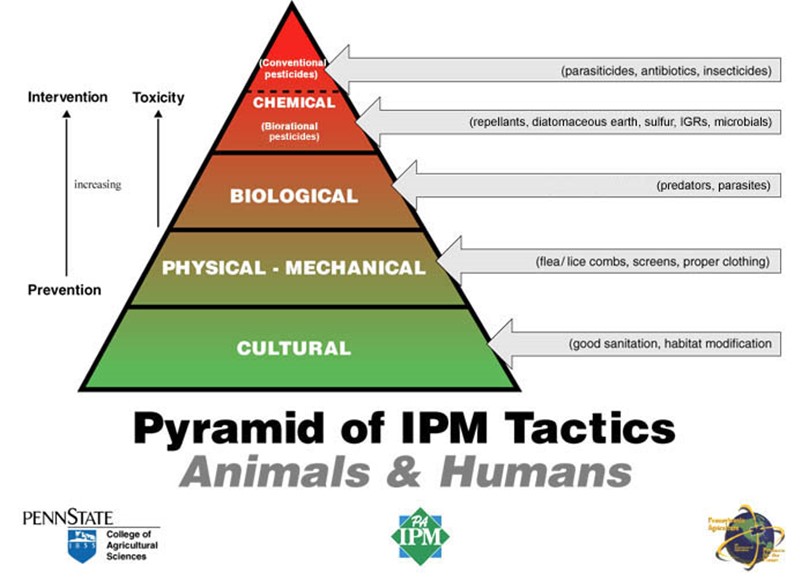
Credit: PennState College of Agricultural Sciences
Cultural
This involves the removal of materials that would serve as breeding media for the flies. Drying manure below 50% moisture will help reduce fly activity. Adding carbon or aerating a composting pile will increase heat that would in turn kill larvae. Stirring or turning manure can aid in disrupting fly life cycles.
Physical
These are limited to screening and glue traps, that are limited in use depending on area of control. For static piles and other short-term storage, tarping piles can be very effective in controlling filth flies. Use a ball-hitch to secure non gromet tarps over the piles. Black plastic sheeting will conduct heat to the surface of the pile killing fly larvae underneath.
Biological
Parasitic wasps and other predators that naturally prey on filth flies can be used. Standing programs exist and should be followed closely for best results. As the prey dwindle down, re-seeding periodically may need to happen to have enough predators in the area to handle new breeding spots.
Chemical
Materials used to kill flies need to be used in accordance to insecticide labels. Strict adherence to dilution and application methods along with PPE requirements need to be followed. A permit or license may be required by state law to apply certain classes of insecticide. Bait is a commonly applied control for adults around composting sheds and manure storage. Use a grass seed spreader to aid in dispersal of material. Log all applications of fly control to monitor effectiveness in the field.
Classes of insecticides need to be documented so that insect resistance will not build up on the farm. Refer to the Insect Resistance Action Committee (IRAC) website [listed in references] to determine which mode of action number your material falls under. Work with your pest control contractor or university entomologist for a pesticide rotation plan to keep resistance down.
Other Vertebrates of Concern
Wild Birds can act as fomites to spread disease and break down stacked piles and composting windrows. House sparrows, starlings, crows, pigeons, and vultures can create problems with storage and staging of littler, manure and compost. Exclusion and harassment are common forms of control around compost sheds and manure storage. Since starlings and house sparrows are not protected species, live traps can be deployed to capture these birds. Sort target birds from non-target birds (release these) as traps are emptied. Netting the underside rafters will also help in reducing perching and nesting in sheds. In the case of vultures digging into compost bins, overlaying the bin piles with cyclone fencing or similar has been found to be effective. Bird spikes on the roof lines and rafter cords, will dissuade birds from roosting. One effective harassment device was the “car lot tube man” that moves as a scare crow to push birds away. Timing needs to be changed to keep birds at bay. USDA wildlife service can aid and assist in determining optimal controls to use for birds that are protected yet are causing problems with windrows and staged manure piles.
Cats and Dogs (including fox & coyote) have been a problem when rolling in manure or digging and pulling birds from compost piles. Exclusion by tarping and trapping are the most effective methods of control. Use of game cameras will aid in effectively determining what type of animal is digging into your windrow. Consult with USDA wildlife service for protected species controls.
Other classes of vertebrates include skunks, raccoons, opossums, mink and others that salvage and can dig into your storages. Similar controls used for dogs and cats can be employed however due to rabies threat, a professional exterminator or state officials that handle these pests may be required for effective control. Game commission staff should be called in for bear sightings.
By using adequate IPM controls and logging and reviewing programs will a farm be able to maintain good biosecurity while handling litter, manure and compost.
References:
Insect Resistance Action Committee
https://irac-online.org/mode-of-action/classification-online/ (accessed: 6/14/2024)
Davison, S.A., Dunn, P.A., Henzler, D.J., Knabel, S.J., Patterson, P.H., Schwartz, J.H., 1997. Preharvest HACCP in the table egg industry. Penn State Cooperative Extension.
https://extension.psu.edu/haccp-in-the-egg-industry-hazard-analysis-critical-control-point-system
Kauffman, P.E., Rutz, D.A., Pitts, C.W., 2000. Pest Management Recommendations for Poultry. Penn State University & Cornell University cooperating.
https://extension.psu.edu/pest-management-recommendations-for-poultry
